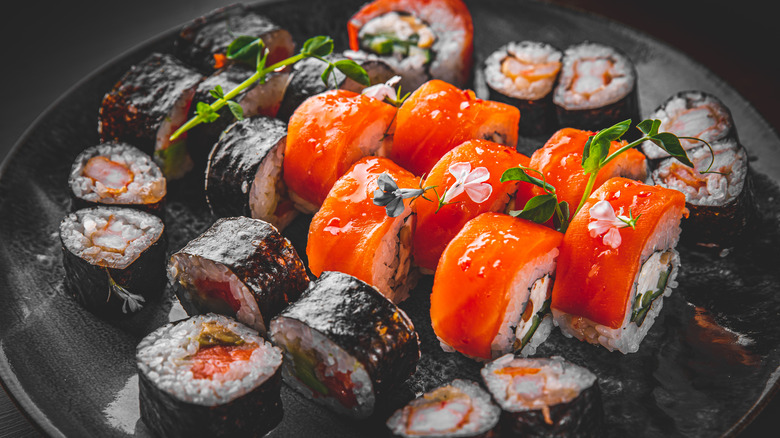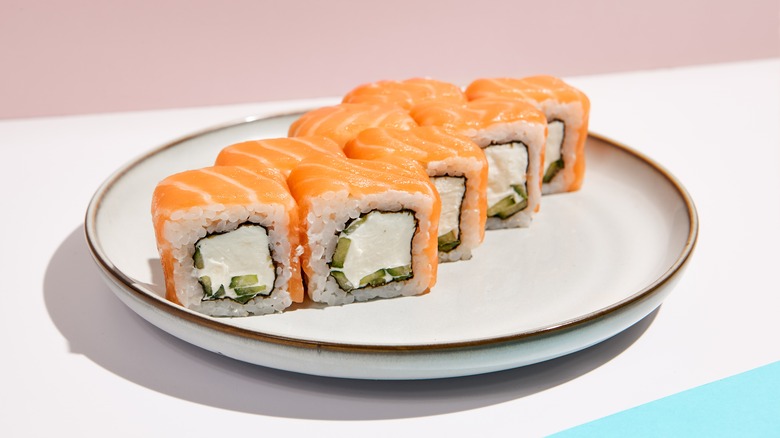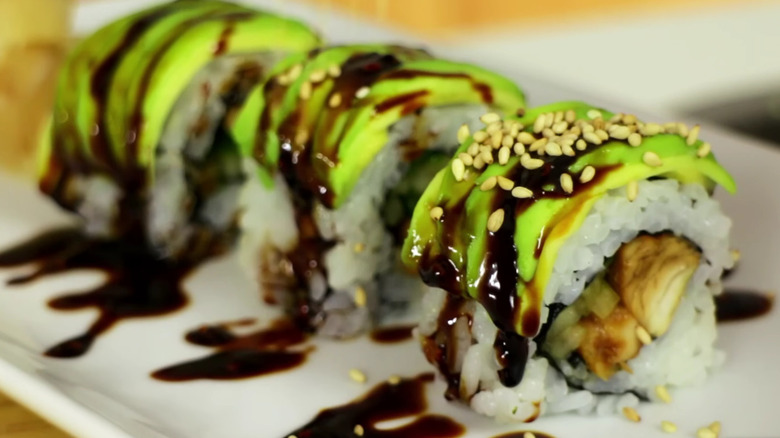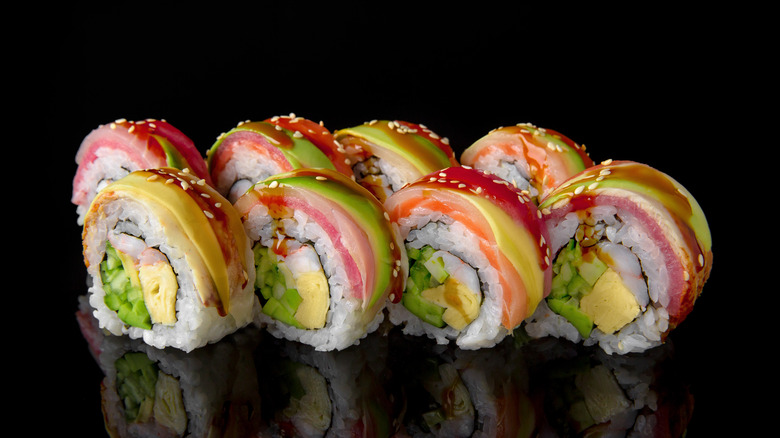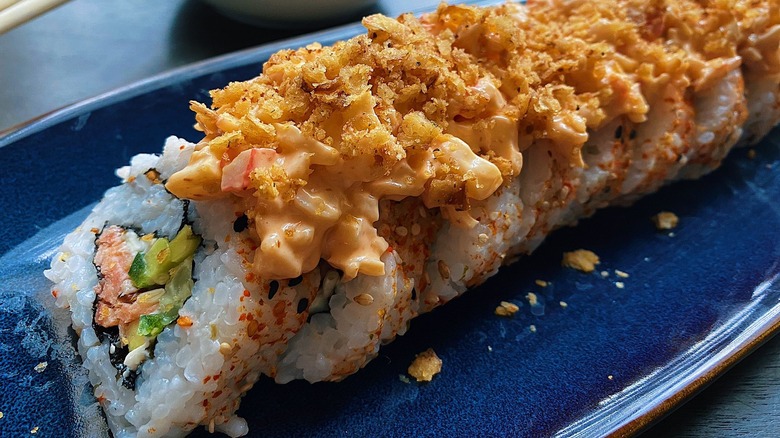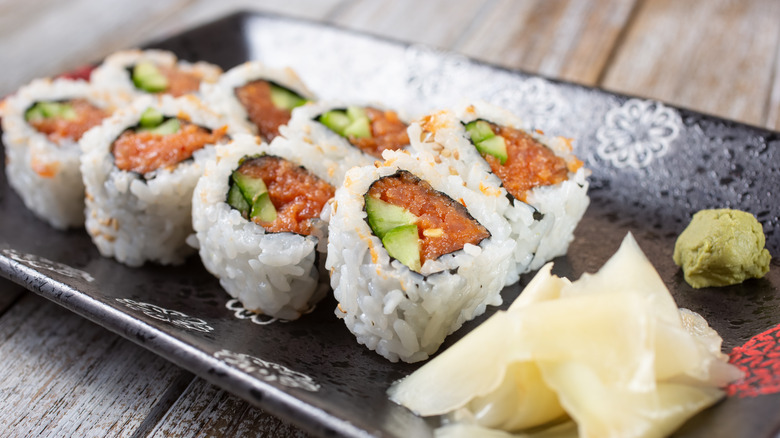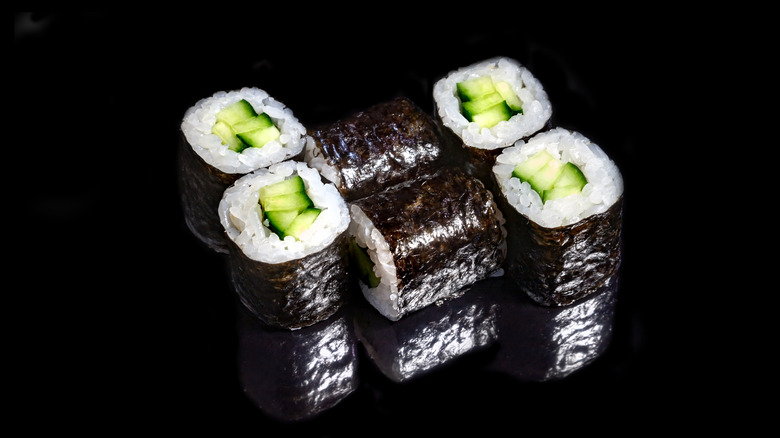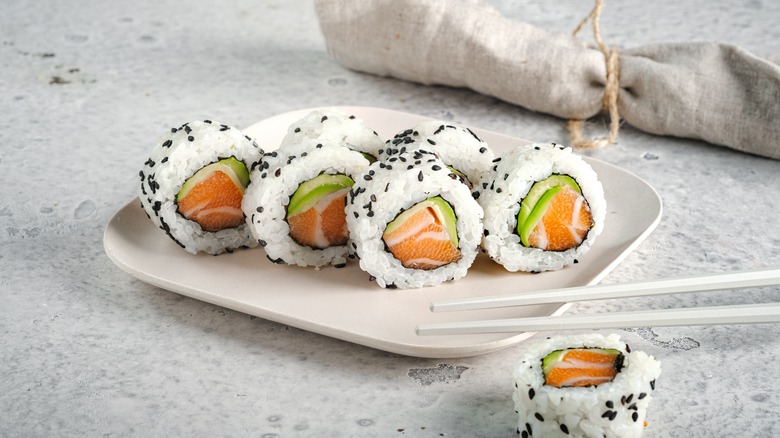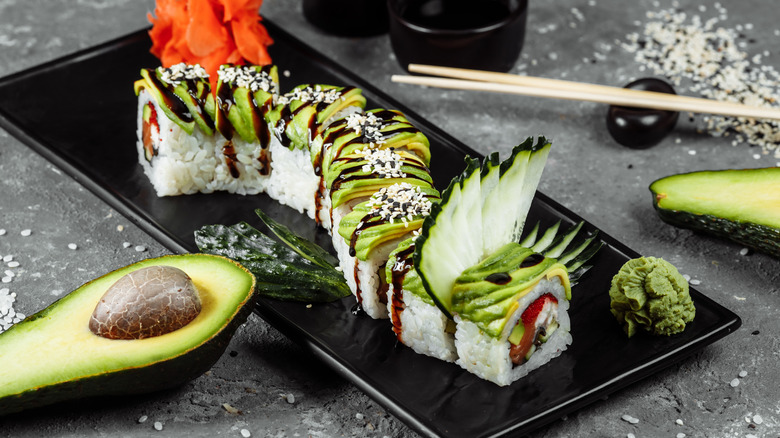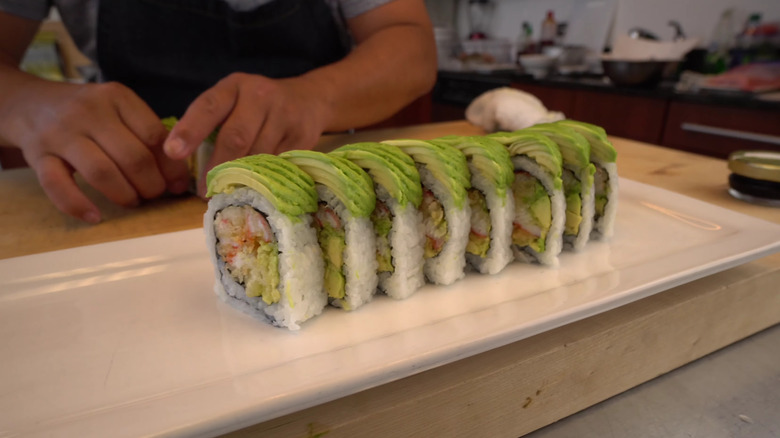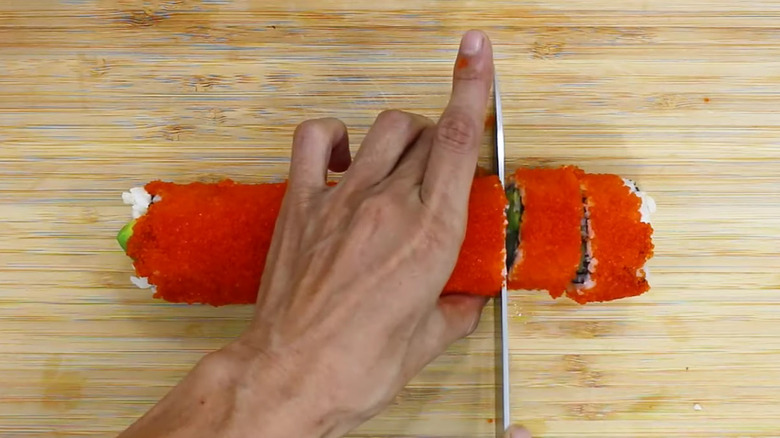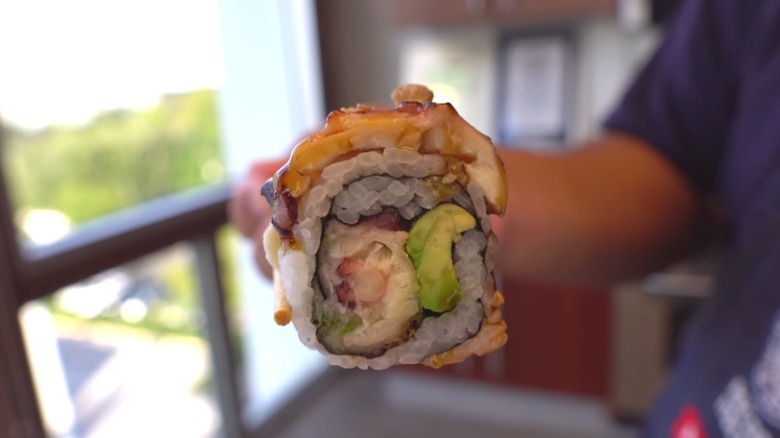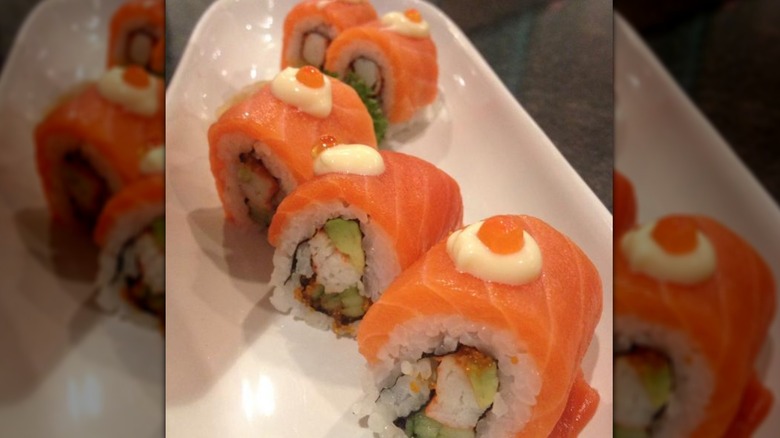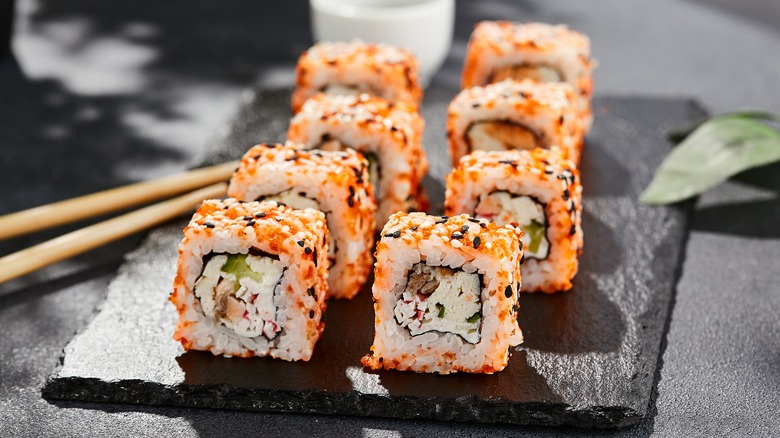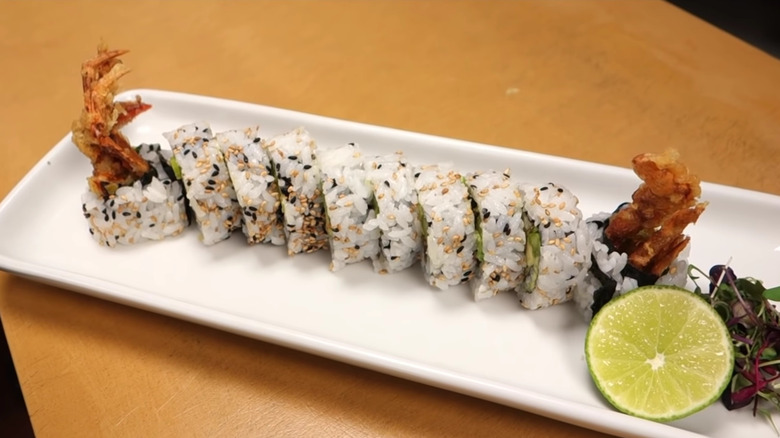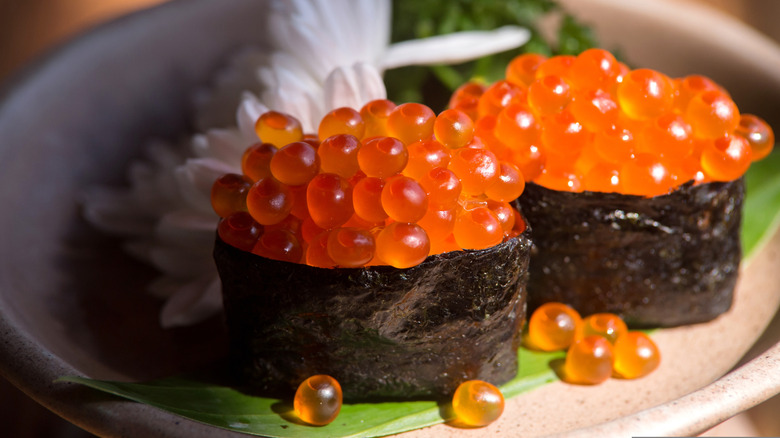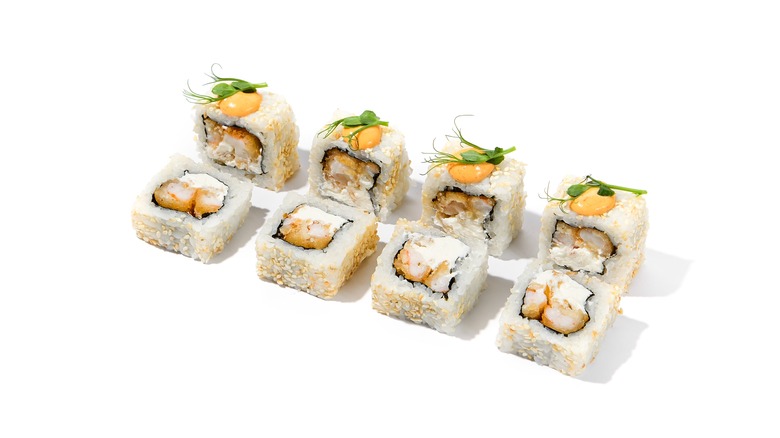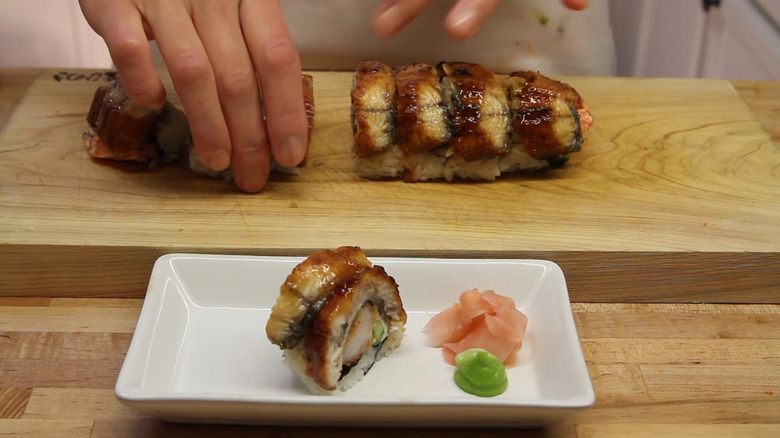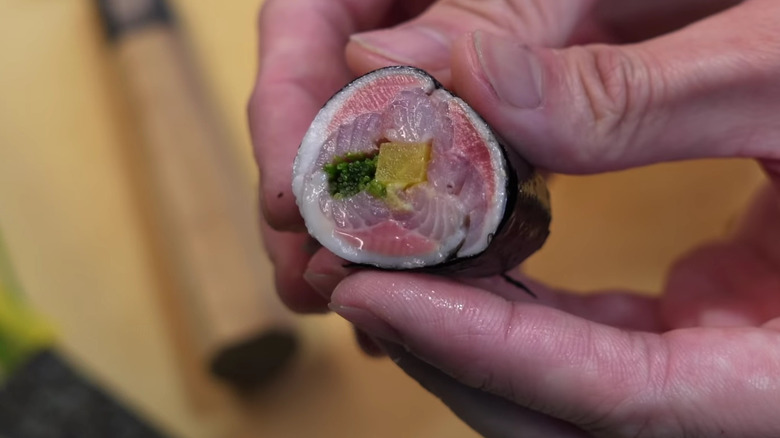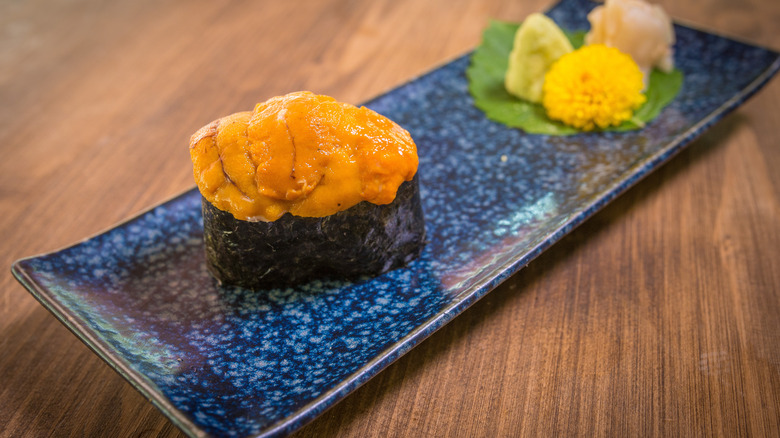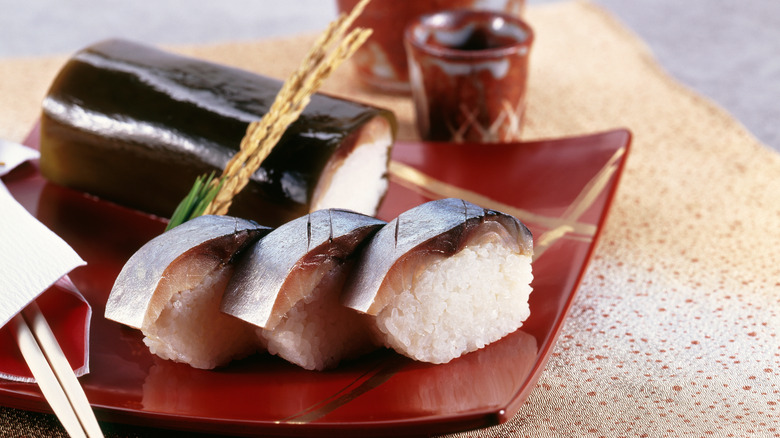20 Best Sushi Rolls, Ranked By Taste And Tradition
While sushi was traditionally made as a means of preserving fish in fermenting rice, the invention of nigiri — small, hand-molded oblongs of rice, usually topped with slithers of fish — brought sushi to prominence, first in Japan and then around the world. As sushi has risen in popularity, restaurants specializing in the rice and fish combination have popped up everywhere from Tokyo to New York.
While nigiri sushi remains popular today, alternative types of sushi have also come to the fore, including sushi rolls. Makizushi, or rolled sushi, is loved for its simplicity, adaptability, and stunning appearance. Usually containing sushi rice, a filling such as tuna, and wrapped in nori, sushi rolls have become one of Japan's most famous cultural and culinary exports.
The American influence on sushi rolls is pronounced, with many being invented in, and named after, American states and cities. What's more, sushi rolls are the most prominent style of sushi served in American sushi restaurants and are often found pre-made in grocery stores around the country.
But which sushi rolls are the best? Of course, this comes down to a matter of opinion, but we have done our best to take into account popularity, tradition, and sustainability when devising this list. So, read on to discover which sushi rolls we deem best and why.
20. Philadelphia roll
The majority of sushi rolls invented in America were designed to cater to a population that had an inherent fear of consuming raw fish. As such, American sushi rolls frequently use cooked fish as one of the main ingredients. The Philadelphia roll is one such example, employing the use of smoked salmon instead of raw. However, what makes the Philadelphia roll unique is not the inclusion of smoked salmon but another distinctly non-traditional addition — cream cheese.
Speaking to the South China Morning Post, Madame Saito, inventor of the Philadelphia roll, highlighted how cream cheese came to be used. "I taught sushi classes at [Philadelphia's] Temple University for 21 years. Back in 1981, nobody knew what sushi was, so I wanted to think of a special creation specific for Americans who didn't eat raw fish at first," she said. "One day a student asked me, 'In California they have their roll, what about us?', then a Jewish customer invited me over for dinner and suggested that Philadelphia's iconic cream cheese would make for a key ingredient. That's how the Philly roll came to be."
While this is an endearing story, it is safe to say that purists still don't have much time for the Philadelphia roll. Yet, it has found a dedicated following and is a popular roll served across both the United States and the wider west. As such, it has earned itself a spot on our list.
19. Teriyaki roll
Most people associate teriyaki with the eponymous sauce, yet the term actually refers to the Japanese practices of grilling food while coated in a glaze. Teriyaki works for a variety of proteins including chicken, beef, and pork. When it comes to seafood, Japanese chefs routinely cook a variety of firm white fish in this manner. Western cooks, on the other hand, prefer to use salmon.
Teriyaki sushi rolls can be made in either the maki or uramaki style, as long as they contain a protein that has been grilled and covered in teriyaki sauce. As a result, these sushi rolls don't contain raw fish. The strong, sweet glaze routinely dominates these rolls, giving them a one-dimensional flavor profile that is at odds with traditional sushi. What's more, teriyaki sauce can often be used to mask the flavor of subpar fish or meat.
Interestingly, a prevalent form of the teriyaki roll contains chicken. This is a far cry from the raw, fish-based sushi rolls that form the basis of all sushi restaurants. For these reasons, we would suggest teriyaki rolls are one type of sushi rolls that are best avoided.
18. Rainbow roll
Another Japanese-American sushi roll creation is the rainbow roll. This Instagram-worthy dish is a type of uramaki, or inside-out roll. This means that the rice forms the outside of the roll while the nori is in the center, a means of construction first trialed with the California roll.
Here, however, the similarities between California rolls and rainbow rolls cease. Instead of the rice being coated with sesame seeds it is covered with several colorful ingredients, including tuna, shrimp, and avocado, hence the name rainbow roll. This over-the-top, non-traditional style of sushi roll is often dismissed by Japanese chefs such as Kotaro Kumita (via City Arts). However, the rainbow roll has gained a following not only in America — where it was invented — but in Japan itself, as reported by Foreign Policy in Focus. This indicates that, while non-traditional, the rainbow roll is bridging the gap between traditional Japanese sushi, and modern American sushi.
17. Firecracker roll
Generally speaking, a firecracker roll can refer to many different types of spicy sushi rolls. As it is a roll not defined by its filling, many variants of firecracker rolls are available, including those made with prawn and salmon. Even vegetarian options abound. While fillings vary, there is one thing many firecracker rolls do have in common, a shared condiment known as togarashi.
Togarashi is a bright red powder made from several ingredients including orange zest, chili flakes, and Sichuan peppercorns. This condiment adds both the kick and citrus tang that characterizes firecracker rolls. As such, firecracker rolls that do not contain togarashi should be viewed with skepticism.
While it adds a lot to firecracker rolls, the powerful flavors of the togarashi do end up masking the flavor of any seafood found in the roll. This results in a final dish that is not as fish-centric as many sushi lovers would like. For that reason, it ranks toward the bottom of our list.
16. Spicy tuna roll
A flavor not often found in traditional Japanese sushi rolls is chili, as the spice is thought to overpower the delicate flavor of the raw fish and vinegared rice. Yet, this hasn't stopped chefs based in America from creating a number of chili-rich sushi options, such as the spicy tuna roll. And many adore the combination of chili and fish.
By their nature, sushi rolls offer an excellent means of using scraps of fish, and the spicy tuna roll is one such example. Food Safety News reports that, instead of whole tuna pieces, sushi rolls — such as spicy tuna rolls — are generally made from tuna scrape, the last bits of meat that are harvested from the carcass once the filets have been removed. While some may turn their nose up at this practice, the scraps that are packed inside sushi rolls use meat that would have otherwise ended up as food waste. This means that rolls like the spicy tuna are, to a degree, environmentally friendly. Jean Nakayama, owner of Maneki restaurant — where the spicy tuna roll was invented — reiterates this in a video created by Thrillist.
15. Kappa maki
To a lot of people, sushi means fish and, more specifically, raw fish. However, vegetarian sushi also has a long history both in Japan and abroad. One of the main rolls associated with vegetarian sushi is kappa maki. Extremely simple in its construction, kappa maki is made from strips of raw cucumber surrounded by vinegared sushi rice and wrapped in nori. Interestingly, the name kappa comes from a beast of mythical folklore that eats — you guessed it — cucumbers.
Its simple and refreshing taste makes kappa maki an inoffensive option for all, especially children and those new to sushi. As such, it frequently acts as an extremely important gateway into the cuisine. For people who are more experienced sushi eaters, kappa maki still plays an important role, most namely as a palate cleanser to be used in between courses, per SushiSushi.
The fact that it is suitable for all has led kappa maki to become both a common feature of sushi menus across the world and one of the most popular vegetarian sushi dishes in Japan. Therefore, we had little option but to include it in our list.
14. Salmon roll
Salmon is a hugely popular fish that can be found in restaurants around the world. As National Geographic reports, Americans alone eat 450,000 tons of the fish every year. And Americans aren't the only population with a taste for salmon; in Japan, 60% of consumers ranked salmon as their favorite fish (via Statista). This makes it all the more incredible that, until the '70s, salmon was not a fish that was used for sushi at all. NPR reports that it was only after the Norwegian government executed a sustained distribution and marketing campaign that salmon became an accepted part of Japan's sushi culture.
Today, salmon is a huge part of sushi around the world thanks to its fatty, oily texture and mild taste, which appeals to nearly all consumers. However, some sushi aficionados dismiss the fish as being too neutral, and undeserving of the acclaim it so frequently receives, leading us to rank it in the lower half of this list, despite its global popularity.
13. Dragon roll
Since sushi was introduced to the United States, the rolls served in the country have become increasingly less traditional. Instead of demonstrating clean aesthetics and flavor profiles defined by restraint, Americanized sushi rolls are typically large, excessively topped, and packed with flavor. A great example of this is the dragon roll.
What constitutes a dragon roll is contested. It is usually filled with shrimp– which are either poached, battered, or fried. Eel and cucumber can also be included in the roll. The defining feature of the dish, however, is the scale-like covering of avocado that is laid atop the uramaki roll. Some recipes call for alternating slices of mango and avocado for the topping. Toasted sesame seeds are also routinely added for decoration and flavor.
Although visually striking, this array of ingredients results in a sushi roll with many contrasting flavors. A confusing, overwhelming flavor profile is not what most people want from their sushi. For that reason, it ranks on the lower half of our list.
12. King crab roll
Thanks to short fishing seasons, king crabs are among the most expensive crabs in the world. The high price is warranted; king crabs' meat is often likened to lobster, as it is incredibly rich. Thanks to this flavor, king crab sushi rolls are highly thought of; the meat is so flavorful that crab is often the sushi roll's only filling. Of course, crisp vegetables like cucumbers are a welcome addition, as they provide some well-needed textural contrast.
There are two drawbacks to king crab rolls. The first is that the texture of the meat can be more challenging than that of the ultra-processed imitation crab many sushi eaters are used to. This was explained by one person on Reddit: "I would wager that real crab rolls seem underwhelming because of the texture of its meat. It's 'stringyness' makes it a bit tougher (especially when cooled) than imitation crab's smooth and soft texture."
Another drawback is the cost. Thanks to the high price of king crabs themselves, king crab sushi rolls are often among the most expensive options on the menu. For these reasons, king crab rolls are placed at No. 12 on our list.
11. Boston roll
Shrimp, avocado, and cucumber make up the Boston roll's filling. This classic, if unimaginative, selection is brought to life through the addition of tobiko, which coats the outside of the uramaki roll. Tobiko is the roe of flying fish. It has a striking red-orange color that really brings the Boston roll to life.
It's not just visual appeal that tobiko adds to Boston rolls, as experienced head chef Hideki Hiwatashi explained to Great British Chefs: "Tobiko tastes like seaweed and I love using it because of its crunchy texture. It works well in Japanese dishes as the flavours complement things like seafood stock, fermented ingredients and raw fish."
The addition of tobiko to this type of sushi roll elevates the Boston roll from mundane to interesting. This, however, is not enough for it to break into the top half of our list; the rest of the roll just does not excite us enough.
10. Tako roll
Octopus might not be the first thing you think of ordering when in a sushi restaurant, but maybe it should be. Not only does octopus offer something different from the usual fare of tuna and salmon, but it is also an ideal option for those who want to eat sushi without having to consume raw flesh. That is because the octopus is normally cooked to boost the meat's flavor and soften its texture before being used to make sushi.
As many know, cooking octopus is notoriously difficult. The Splendid Table highlights that for sushi purposes, one method of cooking octopus is to boil it for no longer than five minutes in order to avoid the meat becoming overly tough. However, the work that goes on beforehand, during the preparation phase — known in Japanese cuisine as teate — will also contribute to the meat's texture and taste, per Slate. This makes it an incredibly useful yardstick to measure an unknown sushi chef's ability. This, along with the unique taste and texture of tako rolls, means we had to include them on our list. However, be warned that experiences can vary, and a poorly cooked octopus will result in a tako roll that is nearly impossible to eat.
9. Alaska roll
There are several sushi rolls named after American cities or states on this list, but none live up to their name as much as the Alaska roll. This is because the roll has a thin layer of raw salmon — a food item closely associated with the state — coats the sushi rice. The salmon not only makes the roll visually striking but also ensures that the sushi roll is rich and decadent in flavor.
Most Alaska rolls are filled with crab, another creature found in Alaska's waters. Higher quality versions of Alaska rolls will include the flesh of premium crab breeds such as king crab. However, it is important to note that cheaper producers will often fill Alaska rolls with imitation crab. This faux crab product is useful in a pinch but does not replicate the clean, delicate flavor of real crab meat. From a nutritional standpoint, imitation crab is also inferior.
When made with fresh seafood, Alaska rolls are some of the best sushi rolls around. The regularity with which faux-crab products are used, however, prevents this sushi roll from ranking any higher on our list.
8. California roll
As the most famous example of Americanized sushi, the California roll has elicited strong responses ever since it was invented in North America during the '60s. The origins of the California roll are shrouded in mystery with some saying it was created in Los Angeles, and others claiming it originated in Vancouver, British Columbia.
The chef who claims to have invented it in Vancouver, Hidekazu Tojo, explained his reasoning behind an inside-out sushi roll to The Globe and Mail. "Another thing Western people did not eat was seaweed, so I tried to hide it. I made the roll inside out," he stated. "People loved it. I was against Japanese tradition with the inside-out roll, but I liked it, and my customers liked it. And so it spread all over -– even into Japan."
While the original versions of California sushi rolls were made with fresh crab meat, a new type of meat has taken its place — imitation crab. Imitation crab meat is a widely-used, cheaper alternative to crab meat, but it does not actually contain any crab meat at all; it's made of white fish, such as pollock, mixed with artificial flavors, thickeners, and sugar. This makes today's California rolls less flavorful and nutritious than they once were, which is why the roll doesn't rank higher on our list. However, if you can find a California roll made with fresh crab meat, we highly recommend ordering it.
7. Spider roll
Soft shell crabs are a delicacy across Asia and elsewhere, thanks to the ease with which they can be eaten. The ability to consume the entire crustacean not only makes them fuss-free for diners but also creates many opportunities for innovative chefs.
When it comes to sushi, soft-shell crab is usually served as part of a spider roll. For this type of sushi roll, meat is paired with carrot and cucumber, allowing the crab's flavor to take center stage. To prepare this dish, whole crabs are usually battered and fried before being placed in the roll. Often, the fried legs are removed prior to slicing, and used to decorate the dish. This gives the rolls the appearance of spider legs, hence the name.
As soft-shell crabs are hard to find in grocery stores, the vast majority of spider rolls are eaten at restaurants. The best restaurants keep their spider rolls simple; any strong-tasting additions to the roll can easily overpower the crab. Unfortunately, some restaurants still drench spider rolls with spicy mayo or other powerful sauces, ruining the flavor balance of this delicate roll. Aside from upsetting the dish's balance, the liberal use of sauce may indicate more nefarious issues, namely that the restaurant is trying to mask the poor flavor of low-quality crab.
6. Ikura roll
Japan is a large consumer of salmon roe, importing around 20,000 tons annually from the United States and Russia, as reported by SeafoodNews.com. Called ikura in Japanese cuisine, salmon roe is tightly controlled for both color and size in Japanese markets, with both needing to be consistent when serving, per Critical Reviews in Food Science and Nutrition. Ikura is used in many ways, one of the most prominent being as a topper for sushi. While frequently used to garnish rolls and other forms of sushi, ikura can also be used to make its very own roll, known as an ikura roll.
An ikura roll is made from a ball of sushi rice wrapped in nori, and then topped with a heap of salmon roe. The roe itself is commonly marinated in sake or soy sauce. The main appeal of this type of sushi lies in both the roe's prestige — it is a highly luxurious ingredient — and texture. The iconic popping of the roe, which releases its briny taste, is a delightful sensation that promises to be unlike anything you have ever tasted before. Hence, the reason this particular roll has earned a respectable place on our list.
5. Shrimp tempura roll
Tempura — thinly battered, deep-fried food — is an integral part of Japanese cuisine. This famously light take on fried seafood and vegetables is served in Japanese restaurants around the world and is so popular that specialist establishments, known as tempura-ya, even abound in Western locations like Barcelona. However, the fact that specialist tempura restaurants are found in Iberia is not shocking. After all, tempura was actually introduced to Japan by Portuguese missionaries in the 16th century.
Tempura sushi rolls are a relatively new concept. One popular version of this new subgroup of sushi is the shrimp tempura roll. Like most iterations of tempura rolls, these are made in the uramaki style, which consists of a chewy rice coating on the outside, with crispy tempura encased in the center, resulting in an enjoyable textural contrast.
Because the shrimp is cooked, the overall flavor of the roll is not overly sweet. Instead, shrimp tempura rolls are balanced-tasting rolls. When combined with their unique texture, shrimp tempura rolls are immensely enticing.
4. Unagi roll
Eel forms an important part of Japanese cuisine and is featured heavily in sushi. This is largely because the meat is celebrated for its savory flavors and delicate texture. While commonly eaten straight off the grill, eel has long been used for sushi, both to top nigiri and as the filling for rolls. In both instances, the eel is always cooked, due to the prevalence of a neurotoxin in the blood which, in even small amounts, can prove fatal to humans.
While unagi is a delicacy throughout Japan, its place in the cuisine is under question, mainly due to the fact that many — although not all — global eel populations have dwindled because of overfishing, pollution, and climate change. The fact that these animals are endangered — sometimes even critically so — does not seem to have curbed appetites. Prices have risen to eye-watering levels, but this has only increased the poaching and trafficking of the animals. What's more, sushi restaurants are loath to abandon such a popular dish, as attested to by South China Morning Post which found that, in Hong Kong, nearly 90% of eel sushi products were made using endangered species. So, while unagi rolls are a traditional delight that you should definitely seek to try, be sure to only purchase them from restaurants that don't use endangered species.
3. Iwashi roll
There is a tendency in the western world to favor mild-tasting fish when eating sushi. In fact, some of the world's most popular sushi rolls — such as salmon and escolar — have achieved popularity thanks to this very fact. While these dishes undoubtedly have their place, in our opinion the best sushi is made with flavorful fish. Usually, this comes in the form of oily, less lauded fish, like sardines.
Known in Japanese as iwashi, sardines are a meaty fish that add an incredible amount of flavor to sushi rolls. Despite this fact, iwashi rolls are somewhat uncommon in the United States, although they are often served in Japan, especially during Setsubun, a Japanese festival.
The lack of iwashi rolls in America can be partly blamed on the massive population decline seen in Pacific Sardines (via NOAA Fisheries) and the American appetite for other, more esteemed types of fish. However, the fact that freshly-caught sardines spoil quickly also plays a part as Masamoto Hamaya, a sushi and izakaya chef, explains to Thrillist. "Sushi chefs in the US have been refraining from serving iwashi. It's a delicacy to eat iwashi raw since it's difficult to have them in a fresh setting." While these obstacles rule out iwashi rolls for many individuals, if sustainable, freshly-caught sardines are on offer, this type of sushi can be some of the tastiest in the world.
2. Uni roll
Sushi often relies on serving marine species that are overfished and endangered. As highlighted by the World Wildlife Fund, many species, such as bluefin tuna, are suffering immense population decline, with stocks over 97% smaller than they once were. The effects of climate change, including warming seas, have also caused marine environments to change. While this has led some species to struggle even more, others have thrived.
One thriving species are sea urchins. These spiny, orb-shaped creatures have seen immense population growth across the world in recent years. The Guardian reports that some groups have seen their numbers swell by 10,000%. The huge populations of sea urchins have devoured kelp forests on America's west coast and elsewhere, destroying habitats that support a rich array of marine life. This has led many to call for increased fishing of sea urchins in an attempt to control their population.
Fortunately, sea urchin is a desirable food item, with a pleasant texture and an almost oyster-like flavor. In Japanese cuisine, they are considered a delicacy and are used to make sushi rolls, known as uni rolls. Uni rolls work because the sea urchin complements other ingredients well. However, we have ranked uni so high on our list not only because of their suitability for sushi but because eating them is a delicious way to help the planet. This is a win-win that is extremely rare in the sushi world.
1. Saba roll
As previously mentioned, strong-tasting fish is an absolute must for satisfying and delicious sushi rolls. This is why mackerel, known as saba, is so good in a roll, as Matt Foreman, a sushi chef, explains to Thrillist. "This is a great fish," he said. "A lot of people get turned off by anything that smells 'fishy.' They quickly associate that smell with something that's gone bad and don't realize that those kinds of flavors and aromas can be delicious. Saba has a great flavor that will stand up to stronger ingredients such as ginger and garlic. Pickled raw for sushi, or grilled and served with some fresh veg, it's a very versatile and tasty fish."
Mackerel has a long history when it comes to sushi, being frequently served both as rolls and nigiri. Another way of eating saba is saba zushi, a hand-pressed roll topped with marinated mackerel that originated in Kyoto.
Furthermore, numerous species of mackerel, including Pacific and Atlantic mackerel, are sustainable sources of fish thanks to robust populations and good management practices, per NOAA Fisheries. This marks saba rolls as one of the few sushi rolls that offers brilliant flavor without exploiting already endangered marine species. With its sustainability and various options for sushi roll types, it's not difficult to see why the saba roll tops our list.
